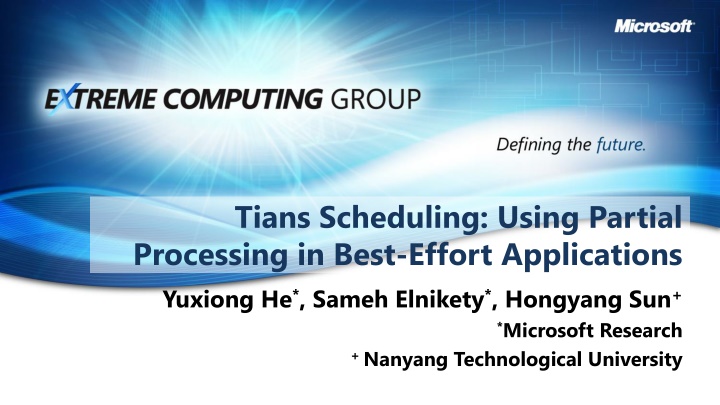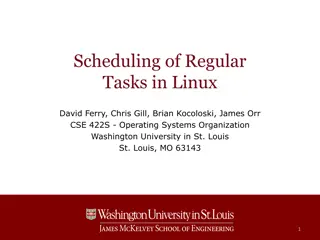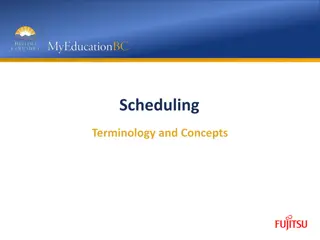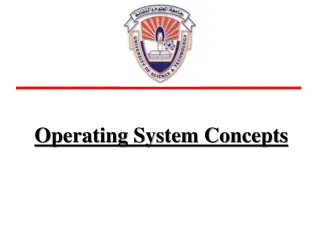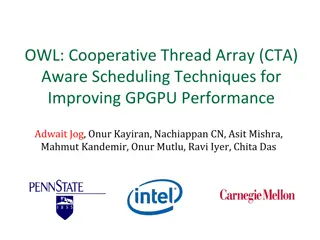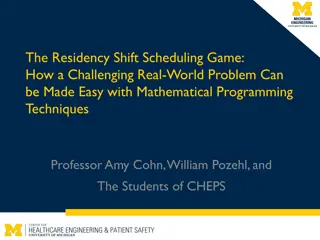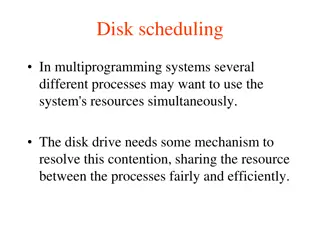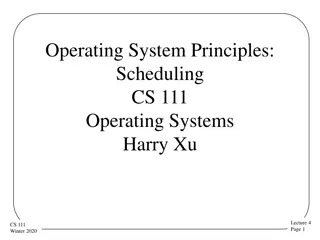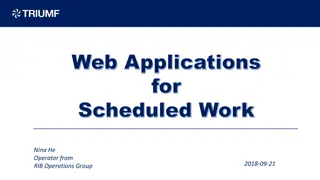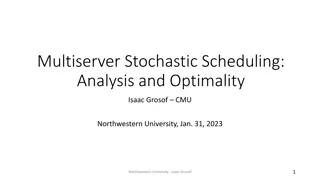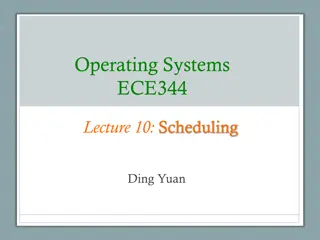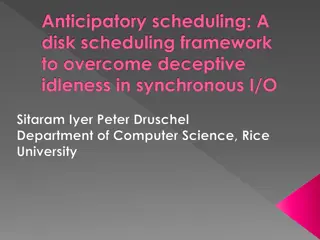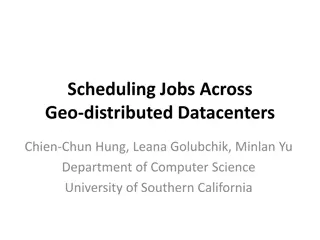Tians Scheduling: Enhancing Interactive Services for Efficiency
Interactive services in data centers face challenges like low server utilization affecting responsiveness and quality. "Tians Scheduling" presents a solution using partial processing to improve system performance while meeting SLAs. By optimizing processing time and request scheduling, it aims to sustain higher load and reduce operational costs, ensuring maximum response quality within deadlines.
Download Presentation

Please find below an Image/Link to download the presentation.
The content on the website is provided AS IS for your information and personal use only. It may not be sold, licensed, or shared on other websites without obtaining consent from the author.If you encounter any issues during the download, it is possible that the publisher has removed the file from their server.
You are allowed to download the files provided on this website for personal or commercial use, subject to the condition that they are used lawfully. All files are the property of their respective owners.
The content on the website is provided AS IS for your information and personal use only. It may not be sold, licensed, or shared on other websites without obtaining consent from the author.
E N D
Presentation Transcript
Tians Scheduling: Using Partial Processing in Best-Effort Applications Yuxiong He*, Sameh Elnikety*, Hongyang Sun+ *Microsoft Research + Nanyang Technological University
Background Interactive services are an important part of data center workload Example: web search, web server, VOD server, etc. SLA Example: web search can require 99% results returned within 150ms. Server utilization for interactive services is embarrassingly low Today high server utilization kills responsiveness and result quality.
FIFO Server: Norm. arrival rate = 0.3 CPU utilization = 30% Example M/M/1 Queue Mean service time = 15ms Deadline = 100ms Quality = 1 if it is fully serviced within deadline; 0 otherwise Average quality 0.99 What is max system utilization? 1 Quality 0.995 0.99 0.985 0.98 0.975 0.97 0.965 0.96 0.955 0.95 0 0.1 0.2 Normalized Arrival Rate 0.3 0.4 0.5 0.6 0.7 0.8 0.9 1
FIFO Server: Arrival rate = 0.3 CPU utilization = 30% Example M/M/1 Queue, FIFO Scheduling Mean service time = 15ms Deadline = 100ms Quality = 1 if it is fully serviced within deadline; 0 otherwise Average quality 0.99 What is max system utilization? 1 Quality 0.995 0.99 0.985 0.98 0.975 0.97 0.965 0.96 0.955 0.95 0 0.1 0.2 Normalized Arrival Rate 0.3 0.4 0.5 0.6 0.7 0.8 0.9 1
FIFO Server: Arrival rate = 0.3 CPU utilization = 30% Motivation M/M/1 Queue, FIFO Scheduling Mean service time = 15ms Deadline = 100ms Quality = 1 if it is fully serviced within deadline; 0 otherwise Average quality 0.99 What is max system utilization? 1 Quality 0.995 0.99 0.985 0.98 0.975 0.97 Goal * Sustain higher load while meeting SLA. * Reduce hardware, energy and operational cost. 0.965 0.96 0.955 0.95 0 0.1 0.2 Normalized Arrival Rate 0.3 0.4 0.5 0.6 0.7 0.8 0.9 1
Characteristics of Interactive Services Deadline with each request Partial results Find the best available result within a predefined response time Quality function Response quality improves with processing time progressive Exhibits diminishing return concave
Traditional System Tians System flexible model with partial results A x B x Strict request model A x Quality Quality B Processing time x Processing time + Tians scheduler Decide processing time of requests Maximize overall response quality while meeting their deadline
Example 3 Jobs, deadline 100 1 Quality 0.9 0.8 0.7 0.6 0.5 0.4 0.3 0.2 0.1 0 0 10 20 30 40 50 60 70 80 90 100 processing time Benefits of partial results J1 J2 J3 Quality Service demand 90 20 100 FIFO 90 10 / 0.98 + 0 + 0 = 0.98 FIFO + partial results 90 10 / 0.98 + 0.27 + 0 = 1.25 Benefits of scheduling Tians scheduling + partial results 40 20 40 0.74 + 0.47 + 0.74 = 1.91
Contribution Propose Tians scheduling for interactive services, embracing partial results. Present three scheduling algorithms Tians-Optimal (offline) Prove its optimality Tians-Clairvoyant (online clairvoyant) Tians-NonClairvoyant (online nonclairvoyant) Evaluate Tians scheduling algorithms using simulation Improve response quality
Outline Introduction Scheduling model Optimal offline algorithm Online algorithms Simulation results Concluding Remarks
Scheduling Model A set of requests Each request has Arrival time Deadline Service demand Quality function maps the processing time the request receives to a quality value Scheduler assigns request processing time maximize total quality of all requests
Optimal Offline Algorithm: Tians-Optimal Three Intuitions 1. When SOEP is feasible, SOEP is optimal. 2. An optimal schedule is composed by SOEP blocks. 3. Jobs in the busiest interval define a SOEP block.
Intuition 1 When SOEP is feasible, SOEP is optimal. SOEP (service-oriented equi-partitioning) policy Each request gets equal share of processing time unless it requires less. Small requests get what they demand Large requests share equal processing time Example: 3 Jobs, deadline 100ms J1 J2 J3 Quality Service demand 90 20 100 SOEP 40 20 40 1.91
Intuition 2 SOEP is not always feasible because of deadlines SOEP not feasible divide into sub-blocks Inside each sub-block, SOEP is feasible An optimal schedule is composed by SOEP blocks. SOEP block1 SOEP block2 SOEP block3 How to identify the SOEP blocks?
Intuition 3 Jobs in the busiest interval define a SOEP block. Inside the block, assign processing time using SOEP
Intuition 3 Jobs in the busiest interval define a SOEP block. Inside the block, assign processing time using SOEP Remove the block and repeat the process on remaining requests.
Tians-Optimal Divide and conquer algorithm: Tians-Optimal([i,j]) { find the busiest block [k,h] apply SOEP on requests in block [k,h] Tians-Optimal ([i,k-1]) Tians-Optimal ([h+1, j]) } THEOREM: Tians-Optimal produces an optimal schedule to maximize the total quality of requests.
Online Algorithms Tians-Clairvoyant Know service demand of released requests Apply Tians-Optimal on the set of ready requests. Tians-Nonclairvoyant Do not know service demand of any requests Apply Tians-Clairvoyant using mean service demand of requests Key features of Tians scheduling: Share processing time equally among requests Prevent long requests from starving short ones Easy to implement in real systems : FIFO, no preemption
Simulation Results Application Web Search Engine Search and rank matching documentss Implement five algorithms Three Tians algorithms FIFO : no partial results FIFO-Partial : support partial results
Web Search Engine Setup Service demand exponential distribution with mean = 26ms Poisson arrival Quality function SLA Deadline 150ms Average quality 0.99
Simulation Result FIFO FIFO-Partial Arrival rate 0.6 Utilization 60% Tians-Noncl. Arrival rate 0.78 Utilization 78% Arrival rate 0.15 Utilization 15%
Simulation Result Gain from partial results FIFO FIFO-Partial Arrival rate 0.6 Utilization 60% Tians-Noncl. Arrival rate 0.78 Utilization 78% Arrival rate 0.15 Utilization 15%
Simulation Result Gain from better scheduling FIFO FIFO-Partial Arrival rate 0.6 Utilization 60% Tians-Noncl. Arrival rate 0.78 Utilization 78% Arrival rate 0.15 Utilization 15%
Simulation Result 420% Tians sustains more than 400% load. Save 80% servers. FIFO FIFO-Partial Arrival rate 0.6 Utilization 60% Tians-Noncl. Arrival rate 0.78 Utilization 78% Arrival rate 0.15 Utilization 15%
Simulation Result 0.15 0.60 0.78 0.90 0.97
Simulation Result Gain from knowing service demand 0.15 0.60 0.78 0.90 0.97
Simulation Result Gain from knowing future 0.15 0.60 0.78 0.90 0.97
More Experiments VOD Server Tians manages the upstream bandwidth Tians-Clairvoyant streams to 40% more clients than FIFO. Variance Reduction Partial results that produces smooth quality function Share processing time equally among requests
Conclusions Tians Partial results + enhanced scheduling Scheduling Share processing time equally among requests Prevent long requests from starving short ones Simulation results Improve response quality To achieve the same QoS, Tians supports much higher system utilization than traditional server.
Future Work Applying Tians in large-scale systems
Thank you! Questions?
